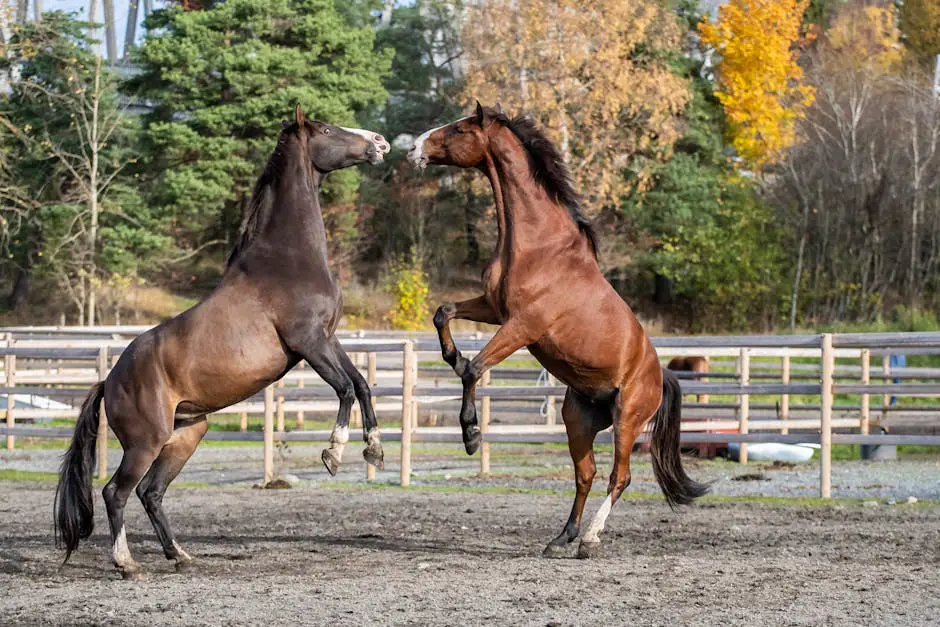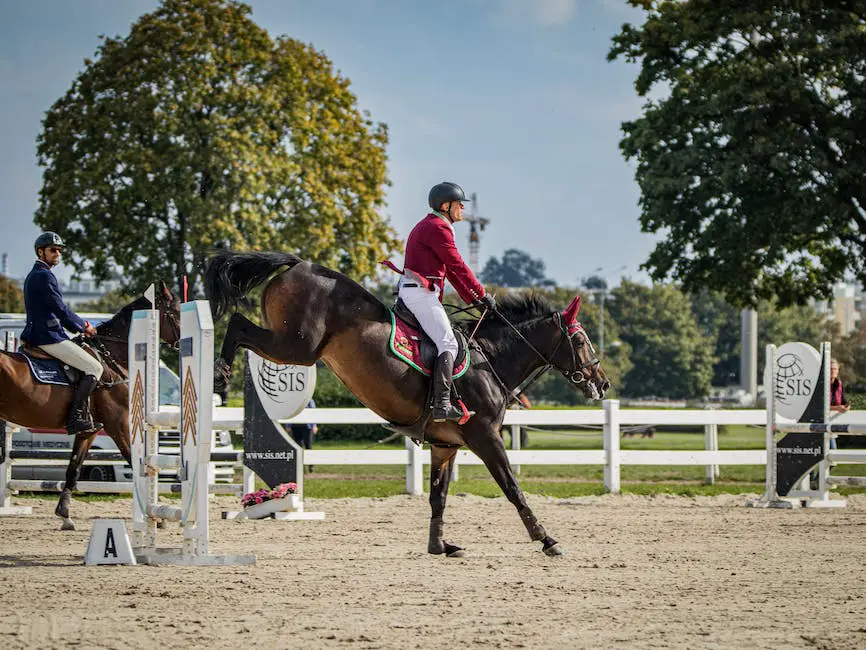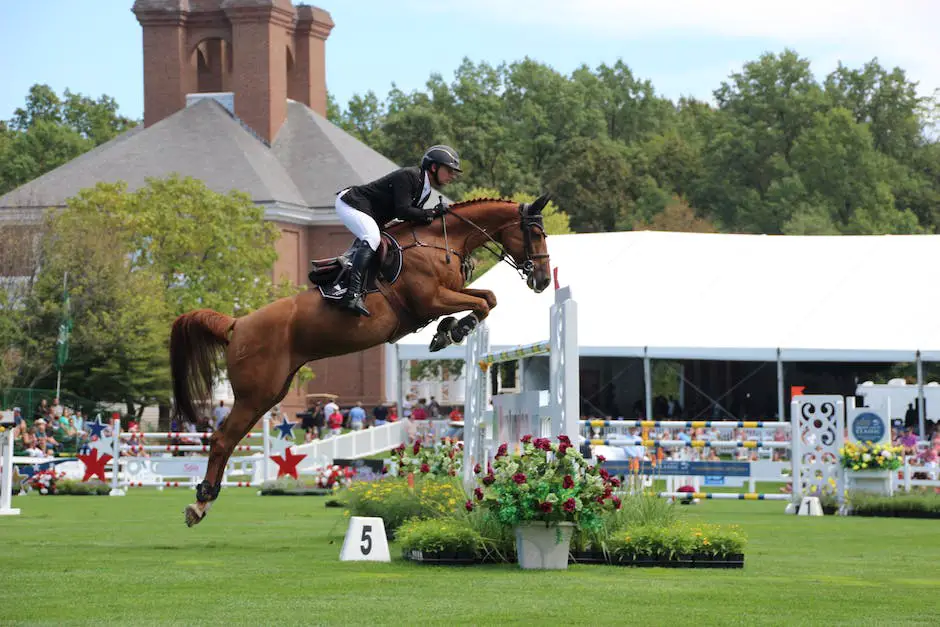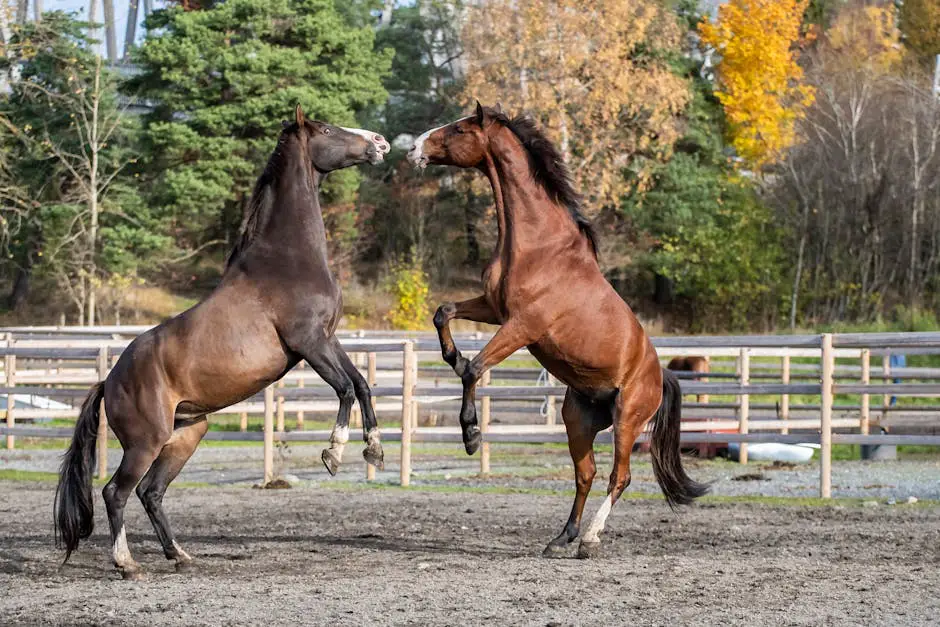The French jumping horse, a symbol of elegance and aerial prowess, carries a storied legacy that is as fascinating as the majestic creatures themselves. Woven into the fabric of equestrian excellence, the saga of the French jumper begins in the lush pastures of France, where breeds like the illustrious Selle Français took their first strides. In examining the rich tapestry of their history and origin, we uncover the impact of pivotal historical events that have shaped breeding practices, spearheading the ascent of these equine athletes in the competitive show jumping arena. With a keen understanding of the genetic marvels and characteristic traits that define them, we embark on an exploration of the skills and partnerships that transform these horses from mere animals into international champions.
Table of Contents (Horspedia)
History and Origin of French Jumping Horses
The Leap to Fame: How French Jumping Horses Vaulted to the Top
Picture this: effortlessly soaring over towering obstacles, magnificent horses displaying strength, agility, and grace. That’s the thrilling world of show jumping, and when it comes to horses that excel at this sport, French jumping horses are often at the forefront. Now, you might be scratching your head, wondering how these French equines became the equivalent of celebrities in the equestrian world. Let’s jump into their story and find out!
First off, you’ve gotta know about the Selle Français. This isn’t the name of a fancy French pastry — it’s a breed of horse specifically developed in France for show jumping and other equestrian sports. How did they do it? Well, they took some of their best native stock, including the Norman Cob and a few other regional breeds, and sprinkled in some thoroughbred and Anglo-Arab bloodlines. It’s like making the ultimate athlete smoothie — each ingredient chosen to give these horses their trademark power and poise.
Why do they stand out in jumping? Strength is just part of the equation. French jumping horses have this special something called “scope.” It’s a term used to describe their ability to jump big and wide while making it look like a walk in the park. Their muscles, the way they’re put together — it’s all just picture-perfect for taking flying leaps over fences nearly as tall as most people.
Any great athlete needs more than just a strong body, though. They got to have the brains to go with the brawn. And the Selle Français? They’re like the honor students of the horse world. They’re known for having top-notch temperaments: calm, cool, and collected. That means when they’re in the ring, faced with a challenging course, they keep their heads clear to navigate those jumps like pros.
Now let’s talk track record. French jumping horses aren’t just a fad — they’ve got history. They’ve been snagging medals and standing on podiums at the Olympics and other major competitions since people started keeping score. A horse named Jappeloup, who snagged an Olympic gold for France back in 1988, was tiny for a jumper. But boy, could he fly! Stories like his have showcased the heart and ability of French jumping horses on the world stage.
Also, France is top-notch when it comes to training. French riders and trainers take their craft seriously and start training horses when they’re young, building up their skills in a way that feels like a natural part of growing up. By the time these horses hit the big leagues, they’ve got a solid foundation that lets them tackle any course with elegance and confidence.
In the end, it’s not just French pride on the line. French jumping horses have earned their reputation through a combination of stellar genetics, expert training, and an undeniable track record of success. They prance into the show jumping ring not just to compete, but to speak volumes of their heritage — one jump at a time. So next time you see one of these agile athletes take off, you’ll know the story of how they became stars of the sport. And who knows? Perhaps you’ll be cheering in French — “Allez, allez, allez!” — as they clear those jumps and race towards victory.

Breeding and Training Techniques
There’s no denying the thrill and beauty of an elite French jumper clearing those towering obstacles with grace and power. Dive into the equestrian world, and you’ll quickly find that breeding and training these majestic creatures is both an art and a science. Here’s the scoop on best practices for breeding and training notable French jumpers.
Breeding Essentials: It All Starts with Genetics
To breed a future star in the show jumping arena, it’s crucial to select the right pedigree. Look for stallions and mares with a proven lineage of athleticism, health, and jumping ability. It’s more than just picking two winners; it’s about finding the perfect match. Consider factors like conformation—that’s the horse’s physical structure and how well it’s put together—as it plays a significant role in a jumper’s capability to perform.
Health and Nutrition: Foundation for a Champion
Next up, ensuring the foal’s health from the get-go is paramount. This means regular vet check-ups and keeping up with vaccinations and deworming schedules. When it comes to feeding, it’s not just about keeping the foal full. Nutritional plans should be tailored to support growth and development, providing the right balance of vitamins, minerals, and energy for the future athlete.
Socialization: Building Confidence and Trust
Socialization in young horses can’t be overlooked. It teaches them to trust humans and be comfortable around other horses and various environments. This will pay dividends later when you start training them for high-stress situations like competition arenas.
Early Training: The Building Blocks
Introduce ground training early on. This isn’t about jumps—yet. It’s about establishing respect and understanding between horse and handler. Basic commands, desensitization to tack, and leading exercises lay the groundwork for a cooperative attitude.
Progressive Jump Training: Teaching Technique
When they’re physically mature enough, introduce them to jumping. Start with small obstacles to build confidence and gradually increase difficulty, always being mindful of avoiding stress or injury. Training sessions should be short but frequent, always ending on a positive note to keep morale high.
Physical Conditioning: Athleticism is Key
Just like human athletes, horses need a fitness regimen tailored to their sport. This includes not just jumping practice, but also exercises like trotting poles, hill work, and flatwork to build muscle and enhance agility.
Mental Preparation: The Psyche of A Jumper
Don’t forget the mental aspect of training. A successful jumper needs to be focused, brave, and eager to work. Varying routines, introducing new challenges, and providing plenty of positive reinforcement can help develop these qualities.
Regular Assessment: Tuning the Performance
Training a jumper is not a set-it-and-forget-it deal. Continuous evaluation of the horse’s progress and well-being is crucial. This might mean tweaking training methods, adjusting diet, or even consulting with a horse behaviorist.
In this high stakes game, where a fraction of a second can be the difference between victory and defeat, following these best practices can make the journey of breeding and training French jumpers a rewarding experience. Here’s to nurturing the next champion that will soar seamlessly over those formidable hurdles!

Famous French Jumping Horses and Riders
Leaping Legends: Iconic French Jumping Horses & Riders Who Made History
The annals of show jumping sport sparkle with the tales of French equine athletes and their human partners who have soared far beyond the standards in the ring. When it comes to pinpointing the most iconic French jumping horses and riders in history, a few names stand out so boldly, they’ve become almost synonymous with the sport itself.
Let’s vault into the legends of French show jumping, starting with the horse often crowned as one of the greatest show jumpers of all time: Baloubet du Rouet. Paired with Brazilian rider Rodrigo Pessoa, this extraordinary Selle Français stallion achieved a three-peat victory at the World Cup Final from 1998 to 2000, emphasizing the power and prowess of French breeding lines. The duo also clinched Olympic bronze in Sydney 2000, etching their names in the annals of show jumping history.
Another horse that captured hearts was Quidam de Revel. This stallion’s performance at the 1992 Barcelona Olympics was nothing short of majestic. He and his rider, Hervé Godignon, helped France secure a team bronze, while his offspring continue to influence the jumping circuit globally.
Not to be overlooked, the partnership between Pierre Durand and the petite but mighty Jappeloup demonstrated that size isn’t everything in the jumping arena. Their remarkable comeback story was capped by winning the gold medal at the 1988 Seoul Olympics, proving that trust and tenacity are key ingredients for success.
Of course, these majestic horses would be no more than raw potential without the skill and commitment of their riders. For instance, the talents of Michel Robert helped bring to prominence exceptional horses like Jumpy des Fontaines and Kellemoi de Pepita. Michel’s finesse and strategic riding propelled these horses to the top of the sport, showcasing the synergy between equine intelligence and rider intuition.
And let’s not leave out the women who have left an indelible mark on the sport. Penelope Leprevost, with her intuitive riding style, showcased the grace and agility of French show jumpers like Flora de Mariposa on the world stage with notable victories, including team gold at the 2016 Rio Olympics.
But perhaps no discussion of French jumping legends would be complete without Henri Prudent. Henri, both as a rider and coach, has influenced the trajectory of show jumping by shaping the careers of countless French horses and riders. His contributions underscore the cultural aspect of passing down knowledge and expertise within the community.
As budding enthusiasts and seasoned professionals alike know, the stories of these French show jumpers serve not only to inspire but also to instruct. They illustrate the heights passion and hard work can reach when united with the athletic artistry of the Selle Français and the unparalleled tradition of French horsemanship.
These awe-inspiring partnerships between horse and rider continue to define the essence of show jumping—a dance of daredevilry and precision, a testament to the relationship between human and equine. Each time a French-bred horse clears those lofty obstacles, it leaps with the legacy of its iconic forebears, and each rider stands on the shoulders of the giants who guided their reins before them.

Competitions and Achievements
Major Competitions Showcasing the Prowess of French Jumping Horses
Leaping Over International Barriers: Where French Jumpers Shine
The realm of equestrian sports is ever-evolving, but the spotlight on French jumping horses in major international competitions bolsters their elite status. Here’s a rundown of top-tier events where these equine athletes captivate audiences and judges alike.
- First on the list is the prestigious Olympic Games, a stage where French jumping horses have historically leaped to success. These global sporting events encompass the pinnacle of athletic achievement, providing a platform for French-bred stars to showcase their years of rigorous training and inherent capabilities alongside the world’s best.
- Then there’s the World Equestrian Games, an event held every four years that is akin to the Olympics for equestrian disciplines. With categories including show jumping, the competition draws top French jumping horses, offering a display of their extraordinary athleticism and connection with the rider on a world stage.
- But it’s not just these quadrennial events that put French jumpers in the limelight. The Longines Global Champions Tour, an annual series of show jumping events, features various locations globally, spotlighting the consistency and adaptability of French horses as they compete on different terrains and against a dynamic roster of international contenders.
- Equally, the FEI Jumping World Cup is a test of endurance, skill, and partnership between horse and rider. French jumpers enter various qualifying rounds with the aim of reaching the final, a testament to their sustained excellence over an arduous season of competition.
- Closer to home, the French jumping circuit itself brims with talent, and no event reflects this more than the Saut Hermès at the Grand Palais. A competition that blends tradition with top-level sport, it is set against the backdrop of Parisian splendor, where French horses perform in front of their compatriots, proudly representing their heritage.
- Moreover, the CHIO Aachen World Equestrian Festival in Germany, though not exclusively a French affair, is often a critical venue where French horses go head-to-head with other world-class breeds. Success here not only emphasizes their physical capabilities but also reaffirms their high standing in the international equestrian community.
- Last but not least, for the young up-and-coming French show jumpers, the FEI Young Horse World Championships at Lanaken provides a platform for young horses to show their potential. It’s a gathering of the future stars of show jumping, where French breeders and trainers pay close attention to the emerging talents that will continue the legacy.
In conclusion, whether on home soil or abroad, you can witness the fusion of grace, power, and agility that French jumping horses bring to the arena. Follow these competitions throughout the calendar year to catch a glimpse of their unyielding spirit and praiseworthy performances that uphold the reputation of French excellence in show jumping.

As we appreciate the heights reached by French jumping horses on the global stage, we recognize the profound journey of growth and victory mirrored in both horse and rider. Their tale, chronicled through stunning performances and enduring bonds, transcends the bounds of sport to touch upon the essence of harmony and excellence. The reverberations of their triumphs echo through the equestrian world, reinforcing the status of France as a crucible of elite show jumping talent. In the dance of hooves and heartbeats, the legacy of the French jumping horse continues to leap forward, inspiring the next generation of enthusiasts and shaping the future of this storied discipline.

